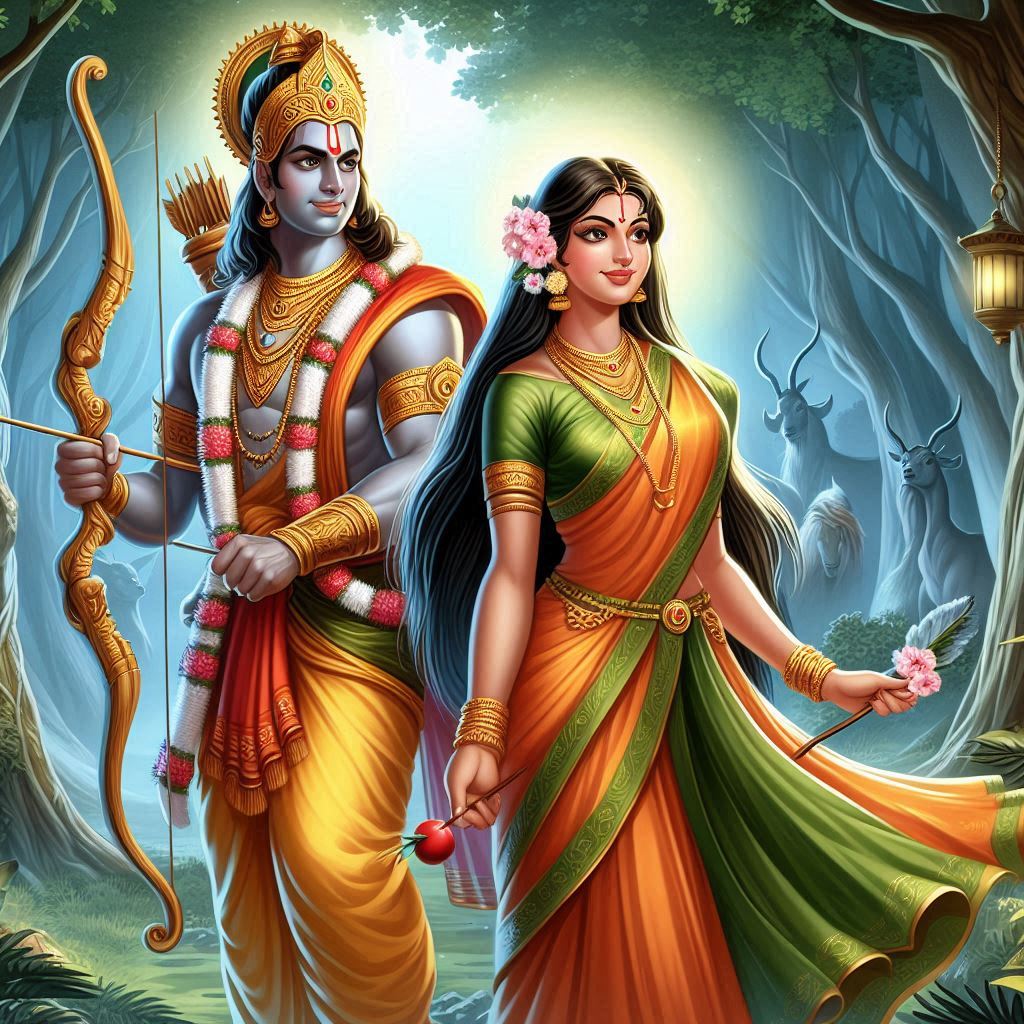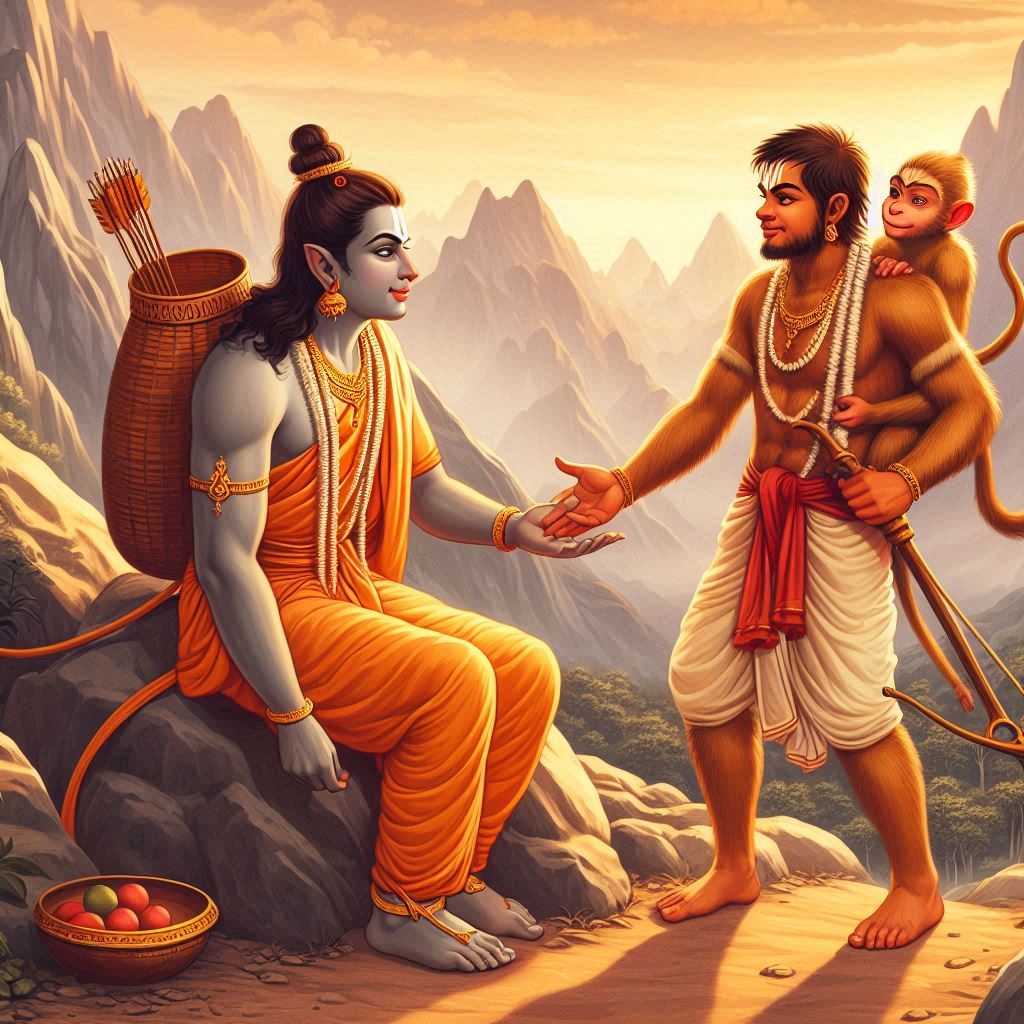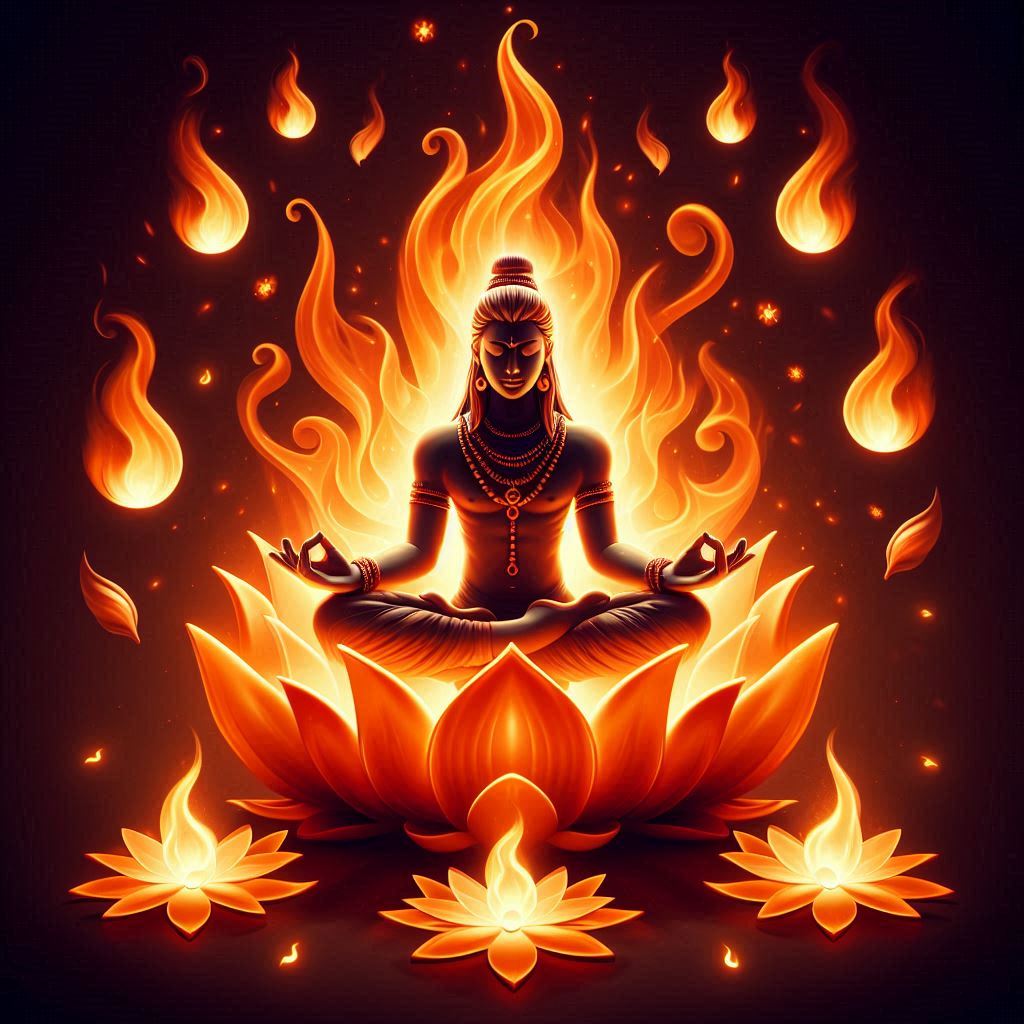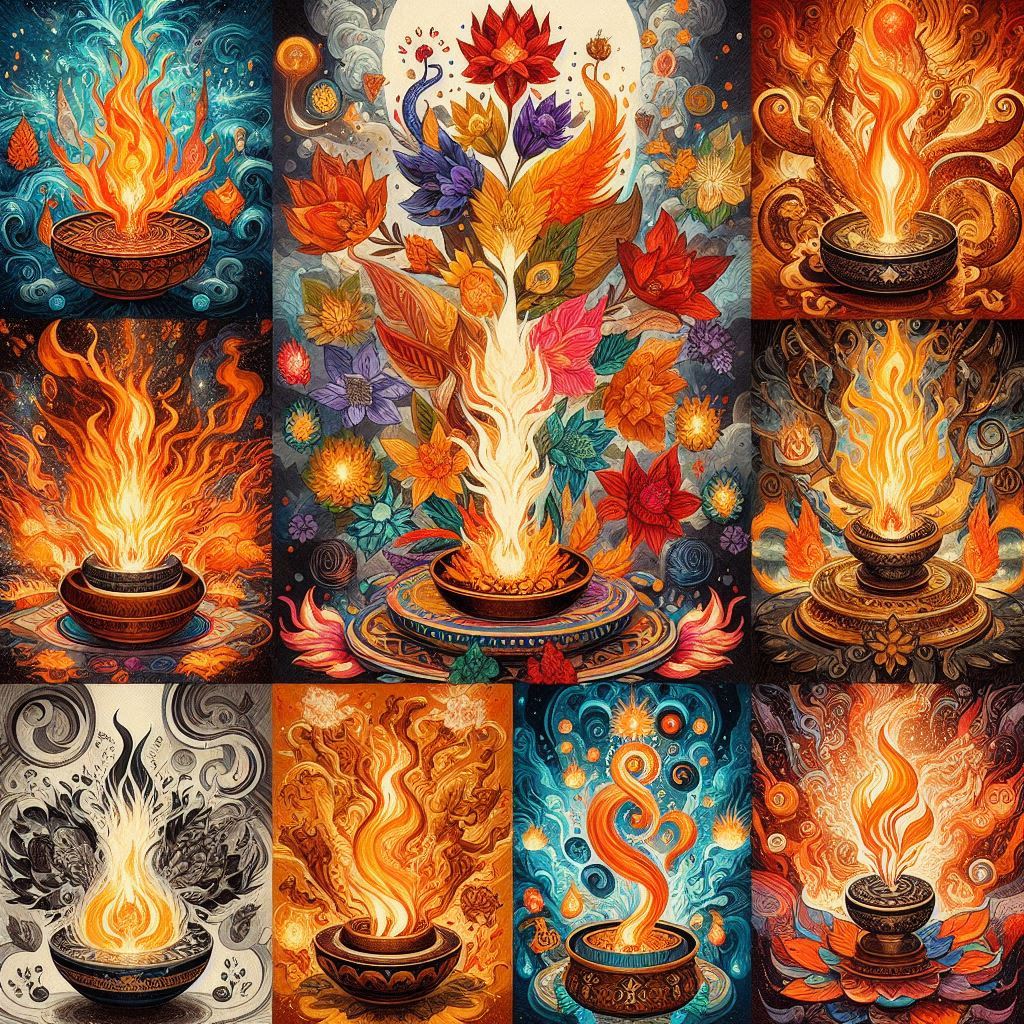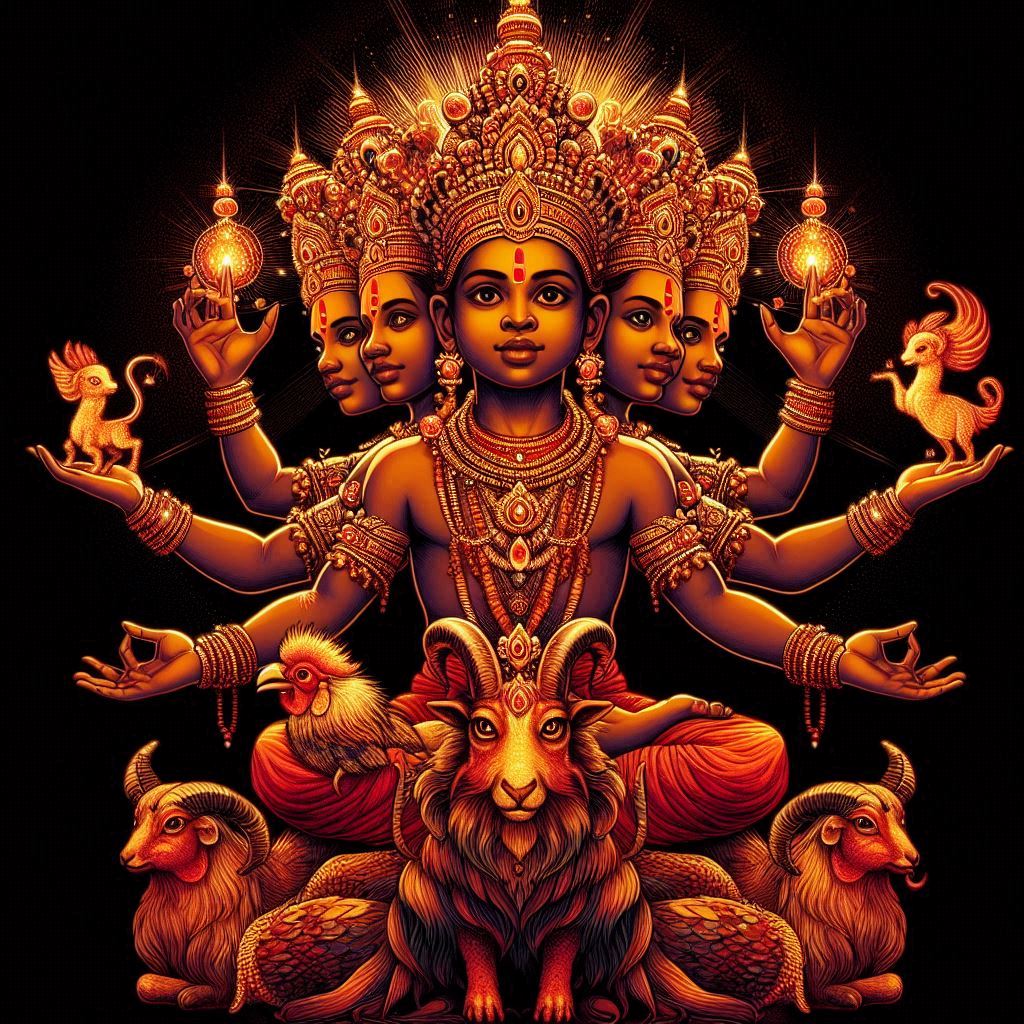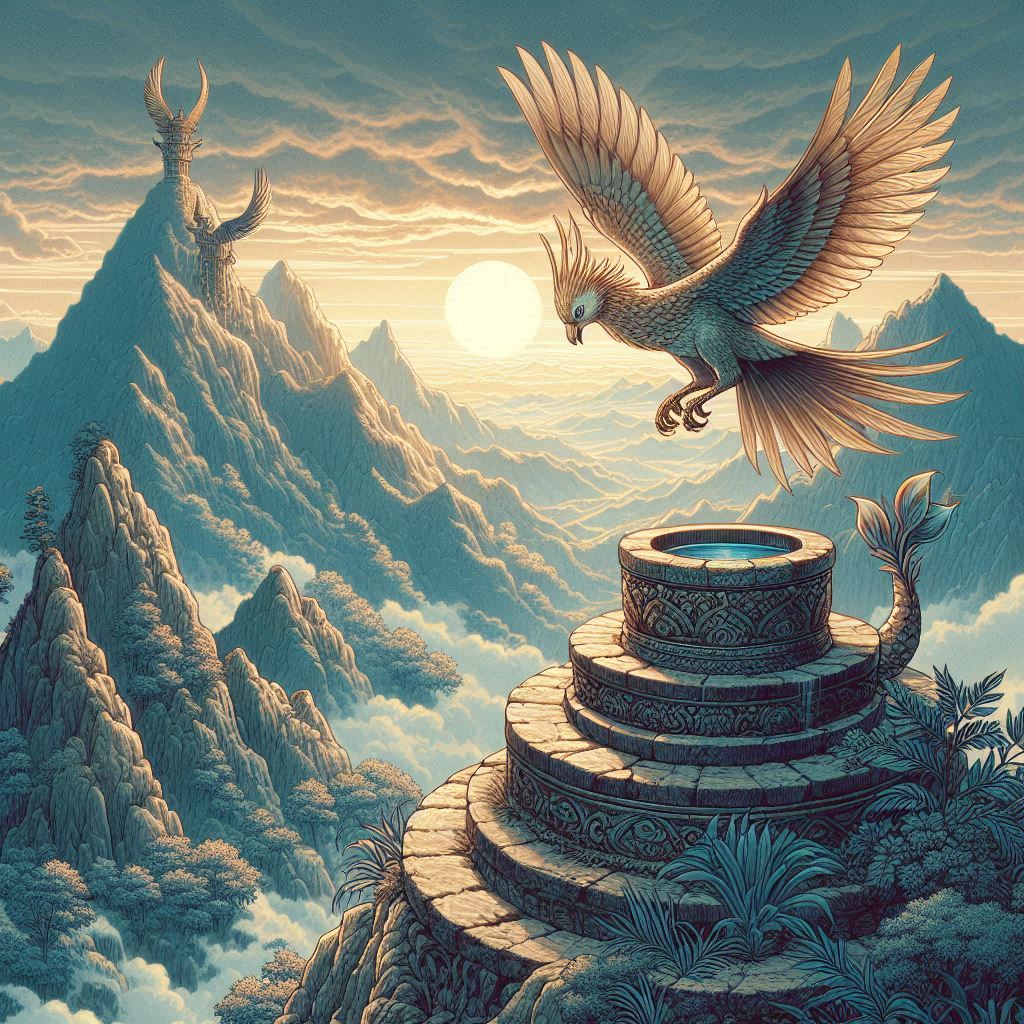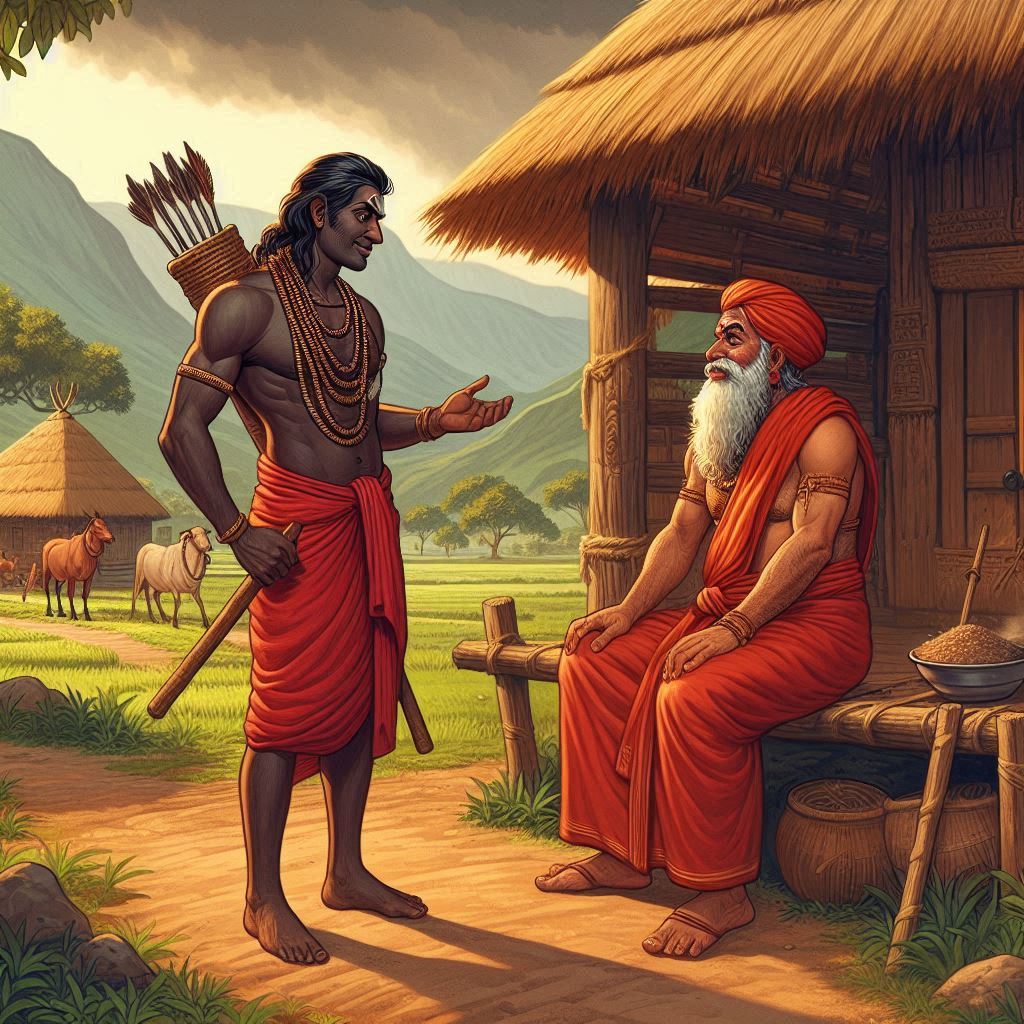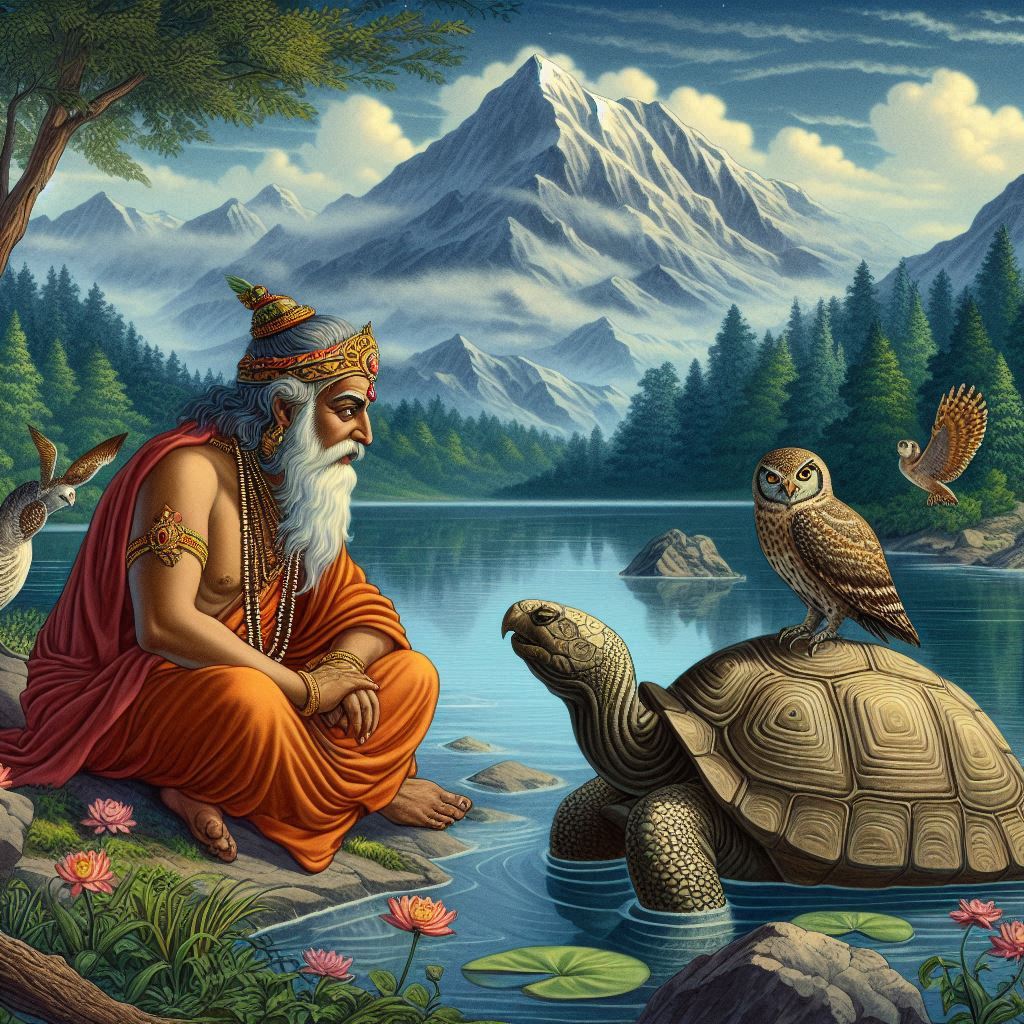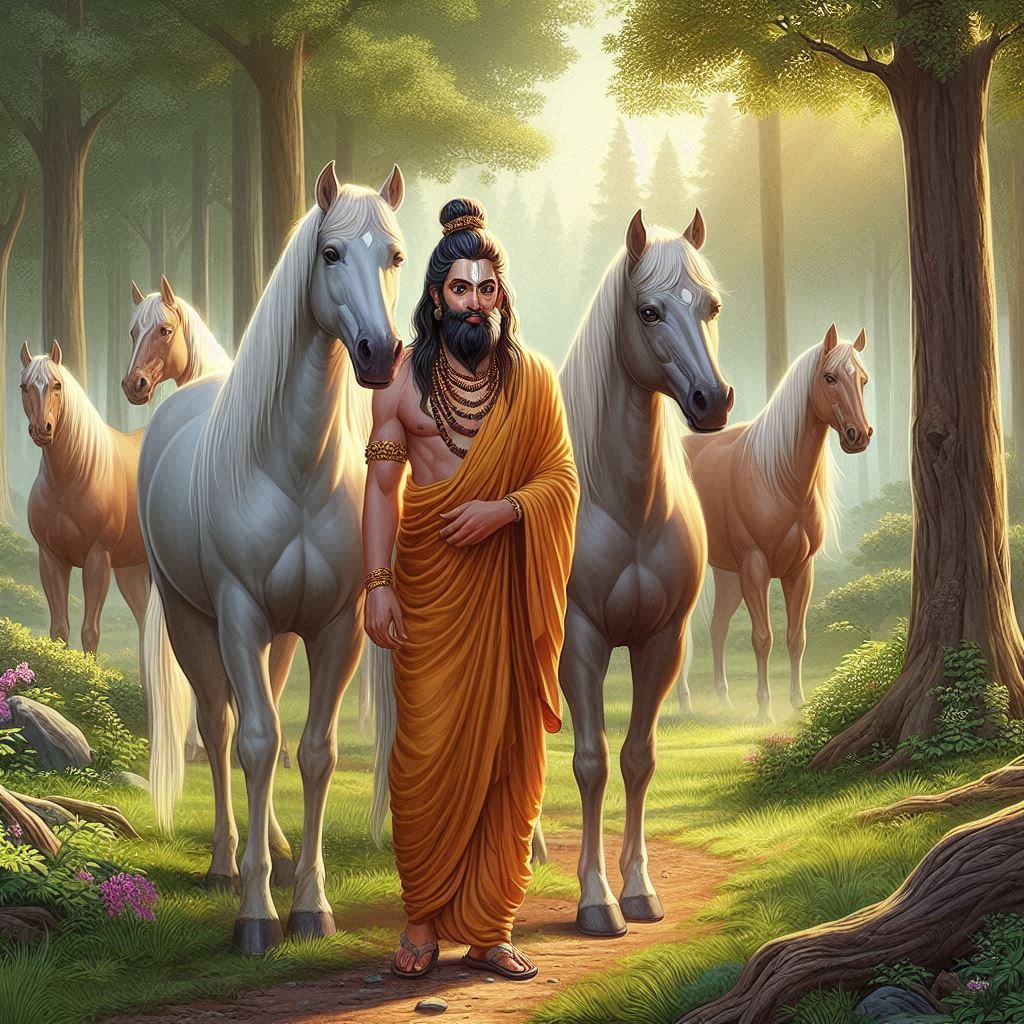After Rishi Markandeya finished narrating Ramayana, Yudhistira said he didn’t grieve for himself but for his brothers and Draupadi. He then asked if the rishi knew of any woman who was as devoted to her husbands as Draupadi was. Rishi Markandeya shared the story of Savitri and how she convinced Yama Dharmaraja to return her husband’s life.
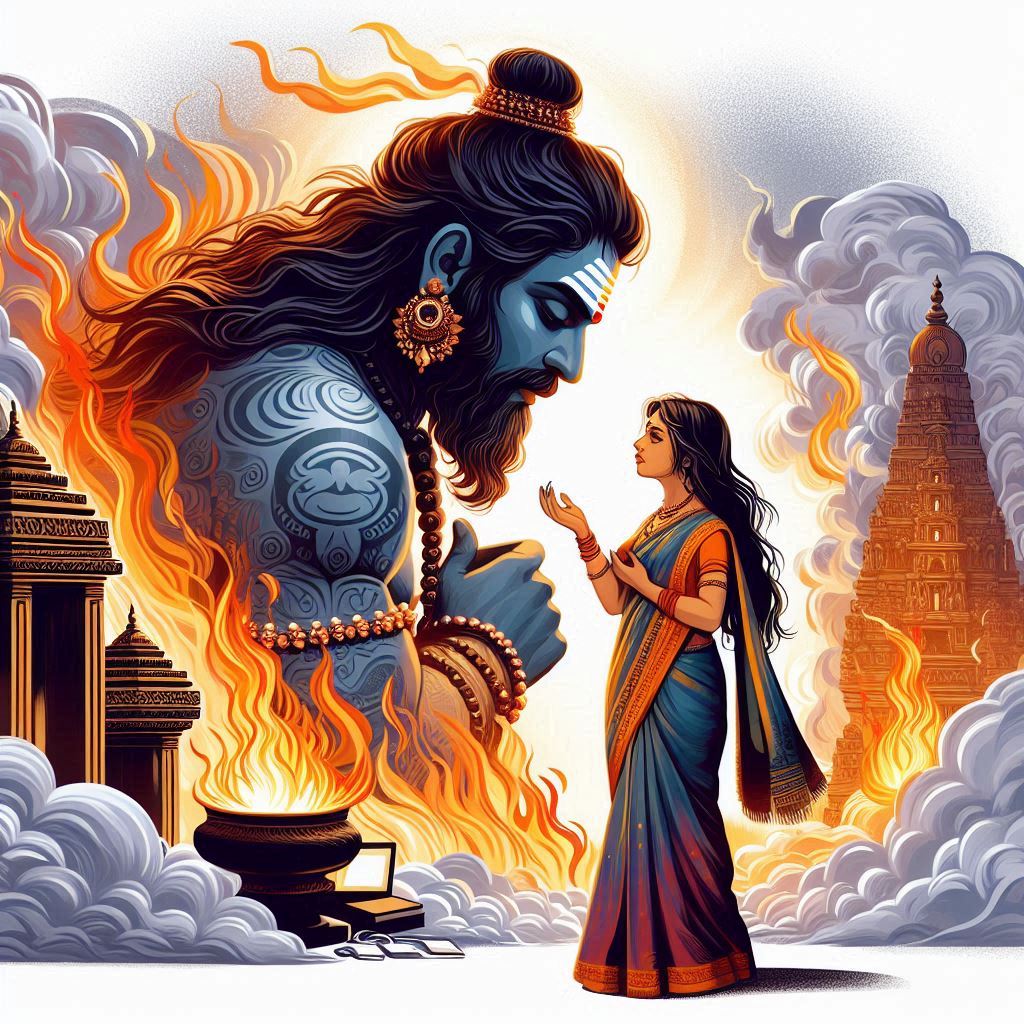
King Ashvapti of Madra was a generous ruler who followed his dharma and gained a good name for his actions. But he didn’t have any children. So, the king performed penance and severe rites like fasting and continued to follow the same for eighteen years. He worshipped Savitri (Gayatri mantra or the feminine form of the sun god).
Pleased with his dedication, Savitri herself rose from the yagna fire and asked what boon he wanted. He asked for sons as he needed offspring. Savitri replied that she had already spoken to Brahma Deva about it, and Ashvapati would soon have a daughter.
The king thanked the goddess and returned to his kingdom, hoping the child would be born soon. His first wife, the princess of Malava, soon conceived and gave birth to a beautiful baby girl with eyes like a lotus. Because she was born after praying to Savitri, the king gave his daughter the same name.
Years passed, and the baby grew into a lovely maiden of marriageable age. She looked like a celestial maiden and thought they weren’t deserving of someone like her. The king was unhappy as he couldn’t find a worthy husband for his daughter. One day, he told her she should search for a husband since no one was coming forward to make an offer. Assigning ministers to accompany her, the king watched his young daughter get into a chariot to find a man who wanted to marry.
Savitri traveled to many hermitages and across the forest lands. She stopped whenever she found older families and took their blessings. She went to sacred sites and gave donations to the Brahmins. Finishing her travels, Savitri returned home. She saw that Narada was also in the court at that moment and took his blessings.
When Narada asked where she went, the king explained that he sent her to search for her husband. Turning to her, Ashvapati asked to share the details of her travels and if she had found a man worthy of being her spouse.
Savitri recounted everything and mentioned the king of Salva, named Dyumatsena. The king lost his eyesight when he was still young, and the neighboring king used this opportunity to attack the Slava and conquer it. Dyumatsena, his wife, and his son were forced to relocate to a forest and have been living there ever since. His son, Satyavan, now a grown-up man, captured her attention. Savitri said she wanted to marry him.
Narada spoke. He told the king that Savitri committed a grave mistake by choosing Satyavan. There was no denying that the young man followed dharma and spoke only the truth. His parents were also pious. When young, he loved horses and would make them out of clay and paint horse dolls. Hence, he was also called Chitrashva. The king asked if he was a handsome man and was generous. Narada assured him that Satyavan was handsome and had all the worthy qualities. He was knowledgeable, humble, respectful, generous, kind, and loving.
The king asked if he had any faults. Narada said Satyavan had only one fault, which was really big. The young man had a short life span. He would die in a year. Ashvapati told Savitri to go and find another husband, as this was too much of a flaw to ignore.
However, Savitri was adamant. She said she already considered Satyavan her husband and would never wed another man. She didn’t care how long he lived. She wanted to be his wife for the year left in his life. Narada told the king that there was no use convincing Savitri, and he should contact Satyavan’s parents to finalize the wedding.
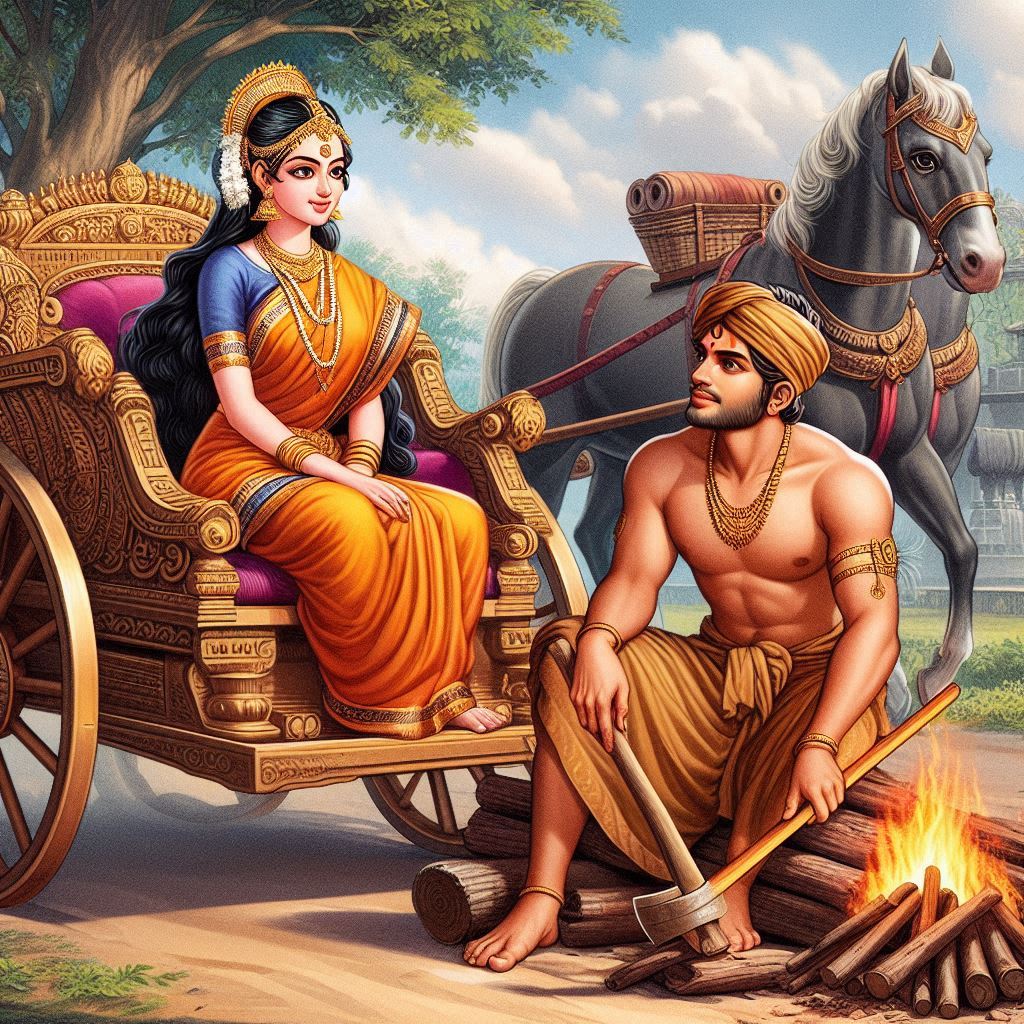
The king had no choice, so he ordered the arrangements to be made. On an auspicious day, he went to Dyumatsena’s hermitage and found the blind king sitting on a mat made of kusa grass. He introduced himself. After the initial pleasantries, Ashvapati explained the matter and asked Dyumatsena to accept Savitri as his daughter-in-law. The blind king said they had no riches and were worried that the princess might not be able to live in a forest like a peasant. Ashvapati assured him that Savitri would happily do so.
Dyumatsena confessed that many years ago, he had hoped to have an alliance with the Madra kingdom, but he let go of the idea when he lost his throne. He said his dream had come true and would give his blessings for the wedding. Savitri and Satyavan were married quickly.
Savitri left her riches in her father’s home and dressed like an ascetic to join her husband and in-laws in her new home. Very soon, her pleasant nature and devotion won their hearts. She took care of the blind king and his wife as if they were her parents, and they loved her just as much. Savitri and Satyavan also had a loving and warm marriage.
The year passed too soon. The day of Satyavan’s death was approaching. A worried Savitri planned in advance. Four days before the marked date, she fasted for three whole days and stood still in the same spot throughout. Though her in-laws tried to convince her otherwise, she didn’t budge. Her father-in-law gave her his blessings.
On the day Satyavan was to die, Savitri woke up early and finished her prayers. Dyumatsena asked her to break her fast and eat something as she was weak. However, Savitri said she would eat in the evening. She took the blessings of her in-laws and the other rishis living nearby. Then, she accompanied Satyavan into the forest as he went to chop firewood.
Satyavan also tried to dissuade her, saying the path would be rough and she was already weak from fasting. Savitri was determined to join him that day. Unable to win, Satyavan led her into the forest, carrying an axe on his shoulder. She reminded him to take blessings from the elders before their journey.
Satyavan showed her many delightful sights on the way. They heard the birds and peacocks cry, saw the stream gushing nearby, and the trees in full blossom. However, her heart was heavy with fear. Satyavan continued to collect fruits and berries in his basket. When they reached a spot, Satyavan said he suddenly felt ill as if his head was swimming. Savitri sat down and urged him to rest with his head in her lap. He did so and closed his eyes in relief. Remembering Narada’s words, Savitri calculated the time of her husband’s demise and sat still.
Soon, she saw a celestial man in yellow garments walking their way. He had a smooth and dark complexion and held a noose in one hand. Seeing him, Savitri lowered her husband’s head onto the ground and stood up. She bowed to Yama Dharmaraja, who personally came to collect Satyavan’s soul. She said she could see he was a god and asked if he could share his name.
Yama introduced himself and said he had come to collect Satyavan’s soul, and since the young man was good and truthful at all times, he decided to do the task himself instead of sending his servants (Yama dutas) as he normally did. Then, he pulled the life force out of Satyavan’s body (it was the size of a thumb) and used the noose to bind it. Satyavan’s lifeless body lay on the forest ground. His job done, Yama proceeded to walk in the southern direction (since it is the direction of death).
A distressed Savitri followed Yama as he left the forest. Yama realized this and turned back to stop her. He told her to go back and perform the last rites for her husband and that hell wasn’t a place for the living.
Savitri replied that she would like to say something to him. She said it was her dharma to follow her husband even if he was being taken somewhere by others, and as his wife, she must abide by the rules of dharma no matter what.
Impressed by her words, Yama said he would give her a boon, anything except her husband’s life, and after that, she should go back. Savitri asked for her father-in-law’s eyesight to be returned and for him to become strong again. Yama granted her the boon. He said she was tired from following him and urged her to go back.
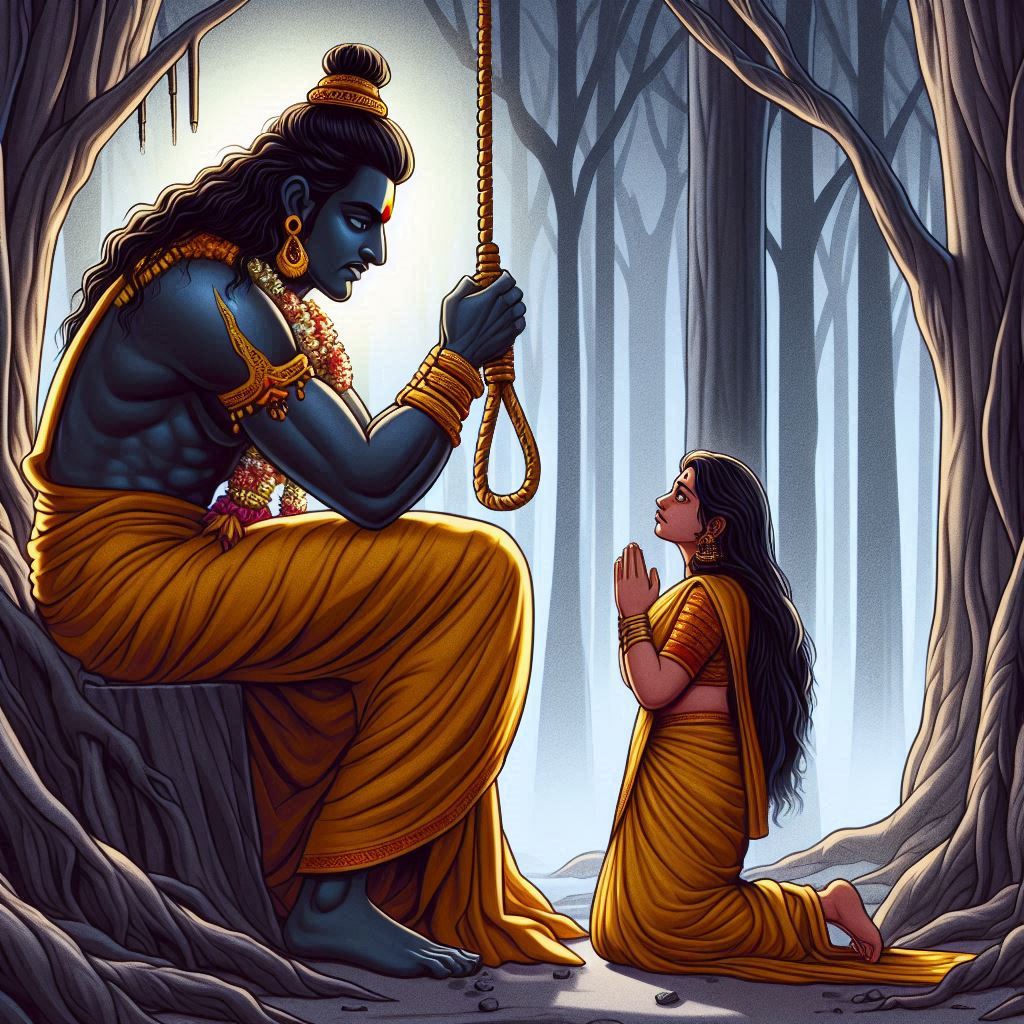
Savitri placed forth another argument. She asked how she could be exhausted when she was with her husband and repeated that she must go wherever he was being taken. Savitri then said that friendship with the virtuous was never fruitless, and one should always associate with such people. Yama was again impressed with her words and told her to ask for another boon, insisting that she should ask for anything except her husband’s life. This time, Savitri asked her father-in-law should recover his lost kingdom and continue to follow the path of dharma. Yama granted her the boon and told her to go back once again.
He walked ahead, with Savitri still following behind. She requested him to listen to her. This time, Savitri talked about Yama himself and said he was the one who controlled all the rules and that even those with compassion could show it only to a certain point. Yama told her to ask for another boon and repeated the same exception. Savitri said her father didn’t have any sons and requested that he have a hundred sons who would be her brothers and continue their lineage. Yama granted her the third boon as well. He asked her to return since she had already travelled too far.
Savitri said it didn’t feel like much distance since she undertook the journey with her husband (even if it was his soul) and said her mind traveled a much greater distance. She asked Yama to listen to her once more. She said he was the son of Vivasvat (sun god) and was equally virtuous. She said he was the king of dharma since no one trusts anyone more than a virtuous person, and making friends with such people is always a blessing, and people would always look up to virtuous people.
Yama yet again said he was pleased by her words and granted her a fourth boon with the same exception. This time, Savitri asked for a hundred sons for herself to be born through Satyavan, and that the sons be dutiful to their parents and extend their lineage. Yama didn’t think much about her request and granted the boon right away.
Savitri didn’t give up yet. She further spoke about dharma, virtue, and how the virtuous ones would never be fruitless nor do they destroy anything, so they are also the protectors. Yama said her knowledge delighted him much and that his respect for her had increased. He told her to ask for an unmatched boon. Now, Savitri took her chance and asked for Satyavan’s life. She said she was as good as dead if he wasn’t alive and with her. She reminded Yama that he had already granted her a hundred sons, and this would be possible only when Satyavan was alive. She asked him to make his words come true by releasing her husband’s soul back into his body.
Yama was impressed by her determination and wit. He happily freed Satyavan’s soul and showed it to her, saying he was returning it to her husband’s body. He blessed her to have a hundred sons like her mother would, and that all the boons he gave her would happen one after another.
He finally made her return to the forest and went back to his abode. She rushed to where Satyavan’s body lay and raised his head to place it back in her lap. Satyavan slowly stirred and opened his eyes. He was bewildered and asked what had happened. Savitri said he rested for many hours, and it was evening by then. He said his head hurt terribly, and he wanted to rest for a while, but didn’t remember anything after that. He looked around at the approaching darkness and urged his wife they leave quickly.
Savitri was more than happy to do so or stay back, depending on how his health was. He said he felt a lot better and had no pain in any part of his body. He also wanted to go and see his parents since they were often worried when he stayed for too long in the forest.
Savitri assured him that his parents were safe and everything was wonderful. They slowly made their way back home in the northern direction, leaving the basket under the tree to collect the next day.
Meanwhile, old Dyumatsena regained his eyesight. Though he marveled at the sudden development, he was too worried about Satyavan and Savitri to wonder about the details. He and his wife, Shaibya, rushed to all the nearby hermitages to ask if their children had come that way. They feared Satyavan had died as it was predicted, and Savitri was distraught or in some trouble. The rishis tried to assure them that their children were safe, but the old couple was restless and repeatedly called out the names of Satyavan and Savitri. The rishis like Suvarcha and Gautama said they saw the events using their tapasya powers and were confident that the young couple was safe and alive.
Soon, Satyavan and Savitri returned to their home and found the rishis around the old couple. Satyavan told them he had slept a long time due to severe pain in the head and which caused the delay. The rishis then revealed that his father, Dyumatsena, had suddenly regained his eyesight.
Rishi Gautama asked Savitri to explain everything, as he knew she was responsible for it. Savitri did so by narrating the events that took place throughout the day and her pleading with Yama, which got them four boons and Satyavan’s life. All the rishis blessed Savitri for bearing the sacred dharma so beautifully and raising the value of her lineage with her actions.
The next day, the news spread far and wide. People from the surrounding regions arrived at their doorstep to see and talk to Savitri, who had achieved the impossible. Meanwhile, a few men from the kingdom arrived to inform Dyumatsena that the current king had been killed by his own advisors and that he should once again be their ruler. After a meeting with the advisors, the old king and his family returned to the city in a royal procession. An auspicious day was chosen to crown Dyumatsena as the king of Shalva with Satyavan as the heir apparent.
Over the years, Savitri and her mother gave birth to a hundred sons each. With her determination, dedication, and love, Savitri not only saved her husband but also brought much happiness to her family.


